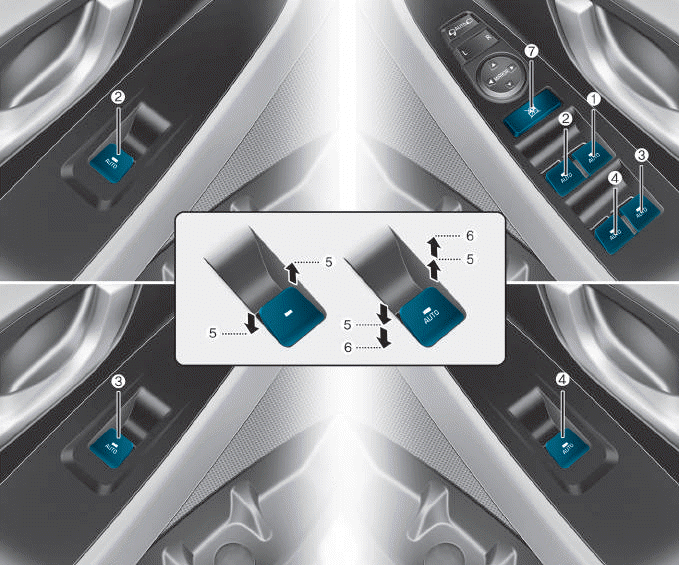Hyundai i-30: Fuel Delivery System / Fuel Pump Control Module (FPCM)
Hyundai i30 (PD) 2018-2025 Service Manual / Engine Control / Fuel System / Fuel Delivery System / Fuel Pump Control Module (FPCM)
Description and operation
| Description |
The fuel pump control module (FPCM) is installed on the right side of the fuel
tank and controls the DC motor mounted inside the low pressure fuel pump.The
module compares instantaneous fuel pressure information measured by the fuel
pressure sensor (FPS) with target fuel pressure information provided by the
ECM and generates the desired target fuel pressure by controlling the fuel pump
motor and regulating fuel flow rate in the low pressure fuel line between the
low and high pressure fuel pumps.

| Operation |

| 1. |
The ECM provides target fuel pressure information to the FPCM via CAN
network.
|
| 2. |
The FPS provides the FPCM with actual pressure information of the low
pressure fuel line between the low and high pressure fuel pumps, and
the FPCM forwards the information to the ECM.Also, the FPCM diagnoses
faults in the FPCM, fuel pump motor and FPS and then provides the diagnosis
information to the ECM.
|
| 3. |
The FPCM compares the actual fuel pressure information measured by the
FPS with the target fuel pressure information provided by the ECM and
controls the voltage that is provided to the low pressure fuel pump
motor.The FPCM keeps regulating fuel flow rate by controlling the low
pressure fuel pump, depending on engine speed (rpm) and vehicle loads.
|
Schematic diagrams
| Circuit Diagram |

| Terminal Illustration |

| Terminal Function |
|
Pin No |
Description |
Connected to |
|
1 |
Fuel sender ground (-) |
Fuel Pump |
|
2 |
Fuel pressure sensor signal input |
Fuel pressure sensor (FPS) |
|
3 |
Fuel pressure sensor ground (-) |
Fuel pressure sensor (FPS) |
|
4 |
Ground (-) |
Chassis Ground |
|
5 |
CAN [Low] |
ECM |
|
6 |
Fuel sender signal (+) |
Fuel Pump |
|
7 |
- |
|
|
8 |
Fuel pressure sensor power supply (+5V) |
Fuel pressure sensor (FPS) |
|
9 |
CAN [High] |
ECM |
|
10 |
Battery power (B+) |
Fuel Pump Relay |
Repair procedures
| Removal |
| 1. |
Release the residual pressure in fuel line.
(Refer to Fuel Delivery System - "Release Residual Pressure in Fuel
Line")
|
| 2. |
Remove the rear seat cushion.
(Refer to Body (Interior and Exterior) - "Rear Seat Assembly")
|
| 3. |
Remove the fuel pump service cover (A).
|
| 4. |
Disconnect the fuel pump control module connector (A).
|
| 5. |
Disconnect the fuel pressure sensor connector (B).
|
| 6. |
Disconnect the fuel feed tube quick-connector (C).
|
| 7. |
Disconnect the vapor hose quick-connector (D).
|
| 8. |
Remove the locking ring (A) by using the special service tool [No.:
09310-F3100].
|
| 9. |
Remove the fuel pump from the fuel tank.
|
 Fuel Pressure Regulator
Fuel Pressure Regulator
Repair procedures
Removal
1.
Remove the fuel pump.
(Refer to Fuel Delivery System - "Fuel Pump")
2...
 Fuel Pressure Sensor (FPS)
Fuel Pressure Sensor (FPS)
Description and operation
Description
The fuel pressure sensor (FPS) is installed on the top of the low pressure fuel
pump and measures the pressure in the low pressure fuel line...
Other information:
Hyundai i30 (PD) 2018-2025 Owner's Manual: Front seat head restraints
The driver’s and front passenger’s seats are equipped with adjustable head restraints for the passengers safety and comfort. Adjusting the height up and down To raise the head restraint: 1. Pull it up to the desired position (1). To lower the head restraint: 1...
Hyundai i30 (PD) 2018-2025 Owner's Manual: Driver’s side fuse panel
Inside the fuse/relay box covers, you can find the fuse/relay label describing fuse/relay names and ratings. Information Not all fuse panel descriptions in this manual may be applicable to your vehicle. It is accurate at the time of printing...
Categories
- Manuals Home
- 3rd Generation i30 Owners Manual
- 3rd Generation i30 Service Manual
- Engine coolant
- Scheduled maintenance services
- To activate the ISG system
- New on site
- Most important about car
Power windows

(1) Driver’s door power window
switch
(2) Front passenger’s door power
window switch
(3) Rear door (right) power window
switch
(4) Rear door (left) power window
switch
(5) Window opening and closing
(6) Automatic power window
(7) Power window lock switch
Copyright © 2025 www.hi30.net




